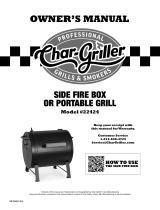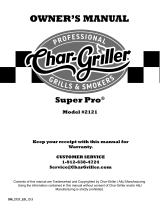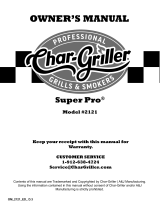King-Griller 3018 Instrucciones de operación
- Categoría
- Barbacoas
- Tipo
- Instrucciones de operación

OPERATING INSTRUCTIONS
Setting Up
Set grill up on solid, at surface with adequate wind shelter. Do not move grill while hot, and do not
leave unattended during operation.
This appliance is designed for use outdoors, away from any ammable materials. It is important that
there are no overhead obstructions and that there is a minimum distance of 12 feet (366 cm) from
the side or rear of the appliance. It is important that the ventilation openings of the appliance are not
obstructed. The barbecue must be used on a level, stable surface. The appliance should be protected
from direct drafts and positioned or protected against direct penetration by any trickling water (e.g. rain).
** PLEASE NOTE: NO RETURNS ON USED GRILLS **
Seasoning and Preparing the Grill
IMPORTANT! BEFORE YOU USE YOUR GRILL FOR THE FIRST TIME
YOU MUST SEASON THE CAST IRON COOKING GRATE(S).
Cure grill prior to your initial use to protect the interior and exterior nish, cooking grates, and to prevent
unnatural avors to your rst meals.
1. Lightly coat ALL INTERIOR SURFACES (including grills, grates, and inside of barrel.) with vegetable
oil (spray vegetable oil is easiest but do not use near hot coals or re).
2. Build a medium sized re on the re grate. Always put charcoal on top of the re grate and not
directly into the bottom of the grill.
3. After coals ash over, spread out coals, replace cooking grates, close lid and heat at approximately
250 F for two hours.
4. Remove grates from the grill with oven mitts, allow to cool, then re-coat grates and return to grill at
approximately 200° F for two hours.
5. You can lightly coat the exterior of the grill body (while warm) with vegetable oil. This will extend the
life of the nish, much like waxing a car. Your grill is now ready for use.
NOTE: Grill will drip oil during this process and for several uses afterwards.
This is normal.
NEVER EXCEED 400°F BECAUSE THIS WILL DAMAGE THE FINISH AND CONTRIBUTE
TO RUST. PAINT IS NOT WARRANTED AND WILL REQUIRE TOUCH-UP. THIS UNIT IS NOT
WARRANTED AGAINST RUST.

BY CHAR-GRILLER®
Lighting Instructions
1. To start a charcoal re, stack 50-60 briquettes in a pyramid and saturate with lighter uid.
NOTE: Do not use gasoline, kerosene or alcohol for lighting charcoal. Use of any of these or similar
products could cause an explosion possibly leading to severe bodily injury.
2. Light coals in several places
3. After briquettes ash over or turn gray, spread them out and start cooking
4. If one end burns faster, use tongs to move coals from one end to the other for even heat.
Grill Operation & Tips
• Control heat with amount and type of fuel, Dual dampers, and adjustable re grate. Adjust grate one
end at a time. Wood burns hotter than coals. More airow is more heat.
• To reduce are-ups, cook with lid in the down position.
• Add water soaked hardwood chips for a smoked avor.
• Ashes left in bottom too long hold moisture and will rust through any thickness of steel. This grill is
made of steel and cast iron, which WILL RUST, ESPECIALLY IF NOT PROPERLY CARED FOR.
• Do not use self-starting charcoal as it will give unnatural avor. Burn lighter uid completely before
closing lid.
• After each use, coat vegetable oil on the interior grates and bare metal while warm to reduce rust
• On the EXTERIOR, remove dust with wire brush and touch up with a high heat paint, available at
most hardware/auto stores.
• You may place a coffee can on bottom shelf under the hole in the grill to catch drippings.
• Heat guage may obtain moisture, which will steam out during cooking. Gauge can be removed and
calibrated in oven.
• You may ll unwanted holes with Nuts & Bolts (Not Provided).
NOTE: Smoke may escape from areas other than the smokestack.
This should not affect cooking.

Finishing Up
When your are nished grilling you can shut down your grill by closing both dampers and allowing the
re to suffocate. Be patient. This may take an hour or more.
Emptying the Ashes & Ash Pan:
** ONLY EMPTY ASHES WHILE GRILL IS NOT IS USE **
After the re is completely extinguished you should wait several hours before emptying the ashes to
ensure they are not still hot and a burn hazard.
1. Knock any ashes that did not fall into the ash pan from the re grate. (If there are pieces of partially
burned charcoal on the re grate you can save them for next time. They are still good).
2. Tap the sides of the re bowl to knock loose any ash that is on the sides.
3. Unclip the ash pan from the bottom of the grill and slide out towards the front.
4. Give the ash pan a few rm taps to loosen any ash that may be stuck.
5. Place the ashes in a metal container and cover with water to ensure there are no lit coals then you
can dispose of the ashes.
IMPORTANT: Charcoal is porous and holds moisture. DO NOT leave charcoal in your grill while
you are not using it. Charcoal and ashes left inside the ash pan may reduce the life of your grill.

INSTRUCCIONES OPERATIVAS
Instalación del Equipo
Coloque la parrillera en una supercie plana y sólida, resguardada del viento. No mueva la parrillera
mientras esté caliente y no la deje sin supervisión durante su operación.
Este equipo está diseñado para ser utilizado al aire libre, lejos de cualquier material inamable. Es
importante que no existan obstrucciones superiores y que haya una distancia mínima de 12 pies (366 cm)
desde la parte lateral o trasera del equipo. Es importante que las aperturas de ventilación del equipo no sean
obstruidas. La parrillera debe ser usada en una supercie nivelada y estable. Debe evitar la exposición del
equipo a corrientes de aire; el equipo debe ser posicionado o protegido contra la penetración directa de agua
que gotee (como por ejemplo, la lluvia).
** ATENCIÓN: LAS PARRILLERAS USADAS NO TENDRÁN DEVOLUCIÓN **
Curando y Preparando la Parrillera
IMPORTANTE! ANTES DE UTILIZAR SU PARRILLERA POR PRIMERA VEZ,
DEBERÁ CURAR LA(S) REJILLA(S) DE COCCIÓN DE HIERRO FUNDIDO.
Curar su parrillera antes del primer uso, protegerá el acabado interior y exterior y rejillas de cocción y
prevendrá los sabores articiales en sus primeras comidas.
1. Cubra ligeramente TODAS LAS SUPERFICIES INTERNAS (incluyendo rejillas, parrillera e interior
del barril.) con aceite vegetal (el aceite vegetal en spray es el más fácil de utilizar, pero no lo utilice
cerca del fuego o brasas calientes).
2. Encienda un fuego mediano en la rejilla de carbón. Siempre coloque carbón encima de la rejilla de
carbón y no directamente en el fondo de la parrillera.
3. Una vez que se cubran de cenizas, distribuya los carbones, reemplace las rejillas de cocción, cierre
la tapa y caliente a aproximadamente 250° F por dos horas.
4. Retire las rejillas de la parrillera con guantes para horno, permita que enfríen y vuelva a
engrasarlas. Colóquelas en la parrillera nuevamente a aproximadamente 200° F por dos horas.
5. Usted podrá cubrir ligeramente el exterior del cuerpo de la parrillera (mientras esta caliente) con
aceite vegetal. Esto extenderá la vida útil del acabado, similar a cuando pule un carro. Su parrillera
está lista para ser utilizada.
NOTA: La parrillera goteará aceite durante este proceso y por los siguientes usos. Es normal.
NUNCA EXCEDA LOS 400°F. ESTO DAÑARÍA EL ACABADO Y CONTRIBUIRÍA A LA OXIDACIÓN. LA
PINTURA NO ESTÁ CUBIERTA POR LA GARANTÍA Y REQUERIRÁ DE RETOQUES. ÉSTA UNIDAD
NO TIENE GARANTÍA CONTRA LA OXIDACIÓN.

BY CHAR-GRILLER®
Instrucciones de Encendido
1. Para comenzar un fuego a carbón, apile de 50-60 briquetas en forma de pirámide y sature con
uido de encendido. NOTA: No use gasolina, querosén o alcohol para encender el carbón. El uso
de cualquiera de estos productos, o de similares, puede causar una explosión que posiblemente
conlleve a graves lesiones.
2. Encienda los carbones en distintos lugares.
3. Luego de que las briquetas se cubran de cenizas o se pongan grises, distribúyalas y comience a
cocinar.
4. Si un lado se consume más rápidamente, utilice pinzas para mover las brasas de un lado al otro
para un calor uniforme.
Uso de la Parrillera y Consejos
• Controle la temperatura por medio de la cantidad y tipo de combustible, con las compuertas duales
y (opcional) la rejilla ajustable para combustible. Ajuste un extremo de la rejilla a la vez. La madera
calienta más que los carbones. Un mayor ujo de aire equivale a una mayor temperatura.
• Para reducir las llamaradas, cocine con la tapa cerrada.
• Añada pedacitos de madera mojados para lograr un sabor ahumado.
• Las cenizas dejadas en el fondo por mucho tiempo, absorben humedad y oxidarán cualquier acero
sin importar su grosor. Esta parrillera está hecha de hierro fundido y acero, lo que SE OXIDARÁ,
ESPECIALMENTE SI NO SE LE DA EL CUIDADO REQUERIDO.
• No utilice carbón vegetal instantáneo ya que le aportará un sabor articial a lo que cocine.
Consuma completamente el uido de encendido antes de cerrar la tapa.
• Luego de cada uso, cubra las rejillas internas con aceite vegetal para reducir la oxidación.
• En el EXTERIOR, elimine el polvo con un cepillo de alambre y retoque con una pintura para altas
temperaturas, disponible en cualquier tienda de herramientas/vehículos.
• Puede colocar una lata de café en la repisa inferior, bajo el hueco de la parrillera, para las gotas.
• El medidor de temperatura puede humedecerse, lo que causará que se empañe durante la cocción.
El medidor puede ser extraído y calibrado en un horno.
• Usted puede llenar cualquier hueco no deseado con Pernos y Tuercas (No Incluidos).
NOTA: El humo puede escapar de áreas distintas a la chimenea. Esto no debería afectar la
cocción.
Finalizando
Cuando termine de cocinar en la parrillera, podrá apagarla cerrando ambas compuertas y permitiendo
que el fuego se sofoque. Sea paciente. Esto tomará un hora o más.
Vaciado de Cenizas:
**SÓLO VACÍE LAS CENIZAS MIENTRAS LA PARRILLERA NO ESTÉ EN USO**

Luego de que el fuego esté completamente apagado, deberá esperar varias horas para vaciar las
cenizas, asegurando que ya no están calientes y no existe peligro de quemaduras.
1. Tumbe cualquier ceniza que no haya caído al recipiente de cenizas de la rejilla de combustible.
(Si encuentra pedazos de carbón parcialmente quemados en la rejilla para combustible, puede
guardarlos para la próxima vez. Todavía funcionan).
2. Golpee los lados del recipiente para soltar cualquier ceniza que pueda estar en los lados.
3. Retire el recipiente de cenizas del fondo de la parrillera, y deslícelo hacia el frente.
4. Golpee ligeramente el recipiente de cenizas para soltar cualquier ceniza que pueda permanecer
pegada.
5. Coloque las cenizas en un contenedor de metal y cubra con agua para garantizar que no se
encuentren brasas encendidas; luego podrá eliminar las cenizas.
IMPORTANTE: El carbón es poroso y conserva la humedad. NO deje carbón en su parrillera
cuando no la utilice. El carbón y cenizas dejados en del recipiente de cenizas pueden reducir la
vida útil de su parrillera.
-
 1
1
-
 2
2
-
 3
3
-
 4
4
-
 5
5
-
 6
6
King-Griller 3018 Instrucciones de operación
- Categoría
- Barbacoas
- Tipo
- Instrucciones de operación
en otros idiomas
Otros documentos
-
 Char-Griller 22424 Instrucciones de operación
Char-Griller 22424 Instrucciones de operación
-
CharGriller 92424 El manual del propietario
-
CharGriller 2130 El manual del propietario
-
CharGriller E3724 El manual del propietario
-
CharGriller 2823 El manual del propietario
-
CharGriller E1224 El manual del propietario
-
 Char-Griller 2121 Manual de usuario
Char-Griller 2121 Manual de usuario
-
 Char Griller 2121 El manual del propietario
Char Griller 2121 El manual del propietario








